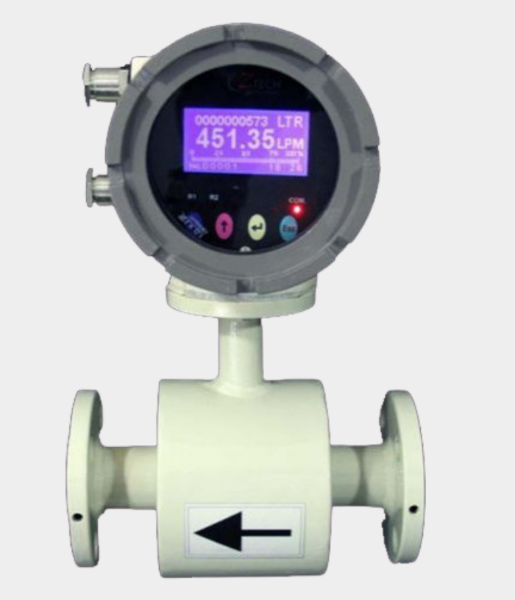Asre Engineering
Flow Control Devices
Electromagnetic flow meter Manufacturer in Mumbai India

Electromagnetic flow meter is a device which measures flow of conductive liquids. This flow meter is true volume measuring meter. And it can measure various types of fluid which can be found across various industrial processes. Application areas of this magnetic flow meter includes Sewage treatment plant, Water supply schemes, Effluent treatment plants, Pulp and paper, distillery, Sugar industry, Steel industry, Chemical, food, pharmaceutical and Drug industry.
This mag flow meter/ Magnetic flow meter measures flow of liquid and it works on the basis of Faraday law of Electromagnetic induction. Faraday law stated that “voltage is induced in electrically conducting body moving in a magnetic field & this voltage is directly proportional to the velocity”. This device has no moving parts and a PTFE lining.
Until the flowing liquid maintains the certain minimum conductivity, flow meter measurement has no effect of pressure, density, viscosity, dissolved / undissolved solids, or temperature. Standard Electromagnetic flow metre outputs include analog, frequency, RS 232/RS 485 or GSM connectivity. As an optional feature local-and remote-display models are available with weather proof & flame proof enclosure with us.
Specifications
- Flange Sizes: 150# ANSI: 15mm to 300 mm (0.5” to 12”)
- Maximum Pressure: 10 kg/cm 2Minimum
- Display: Digital
- Conductivity: 10 uS
- Output 4-20mAdc or Modbus RTU
- Electrode Material: SS316, others optional
- Environmental Temperature: -5 to 55 oC (23 to 131oF)
- Graphical LCD, Velocity Display Liquid Temperature: 0 to 150oC (32 to 302oF)
- Accuracy: +/-1% of span
- Application Media: Water, Any conductive Liquid
- Flow Range: 0.3 to 10 m/s
- Power Supply 230 VAC
- Frequency: 0 to 1000 Hz
- With galvanic isolation
- Protection: IP67
- Electronics Enclosure IP67
Applications
- Automobile Industries: Flow measurement of coolant, for radiator efficiency.
- Boiler: Feed Water Measurement.
- Chemical Industries: Measurement of acidic, alkaline chemicals, slurries with & without dissolved solids.
- Effluent Treatment: Untreated as well as treated effluent measurement.
- Food & Beverages: Special end connection like sms union, triclover clamp, fully SS body, PTFE or PFA liner available.
- Industrial Utility Management: Measuring water consumed by each plant. Water audit.
- Measurement of Spent wash, Fermented wash molasses etc.
- Sewage Treatment: Waste water measurement, Sludge measurement etc.
- Sugar Industries & Distilleries: Measurement of imbibition water, raw juice etc.
- Water Supply Schemes: Raw water as well as treated water measurement.
Advantages
- Wide range of sizing DN 25 to DN 350
- End Connection: Flange type available in various standards viz. ANSI, DIN, BS etc.
- Unaffected by the temperature, pressure, density, or viscosity of the liquid.
- Able to detect liquids that include contaminants (solids, air bubbles)
- There is no pressure loss.
- No moving parts (improves reliability)
Disadvantages
- Cannot detect gases and liquids without electrical conductivity